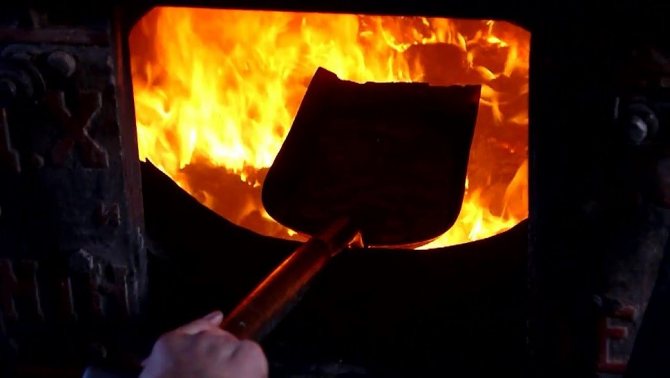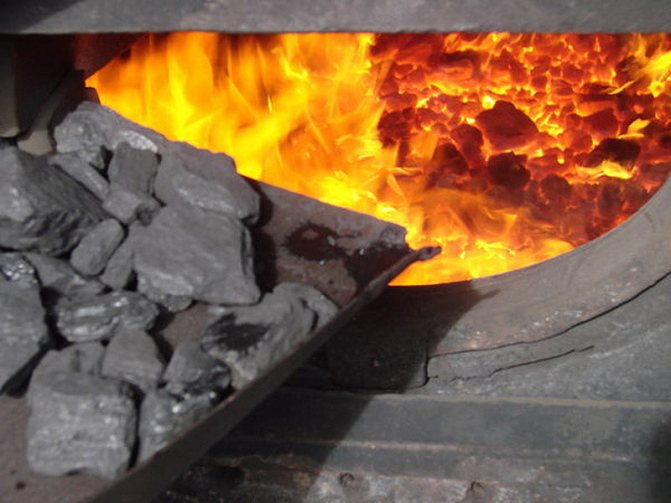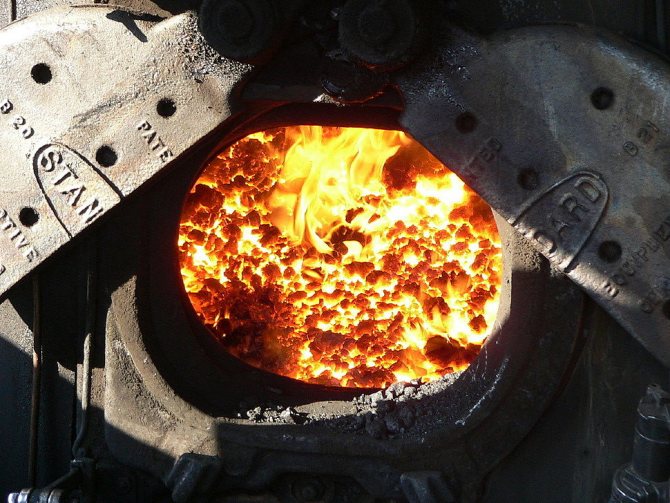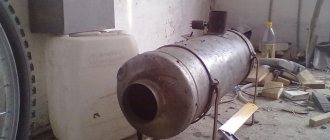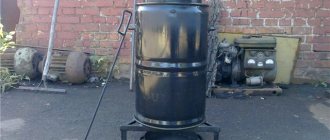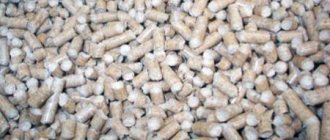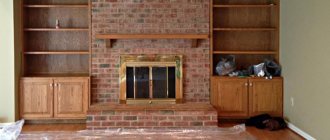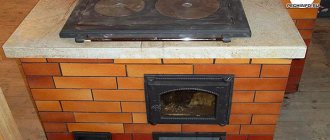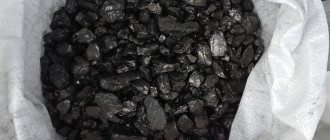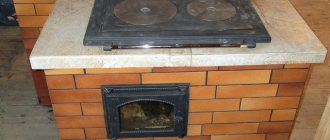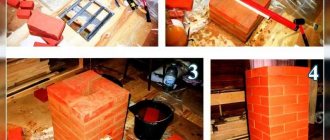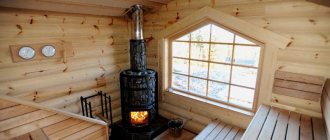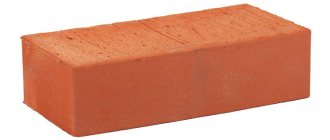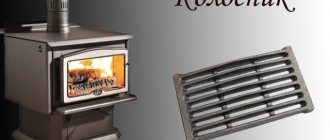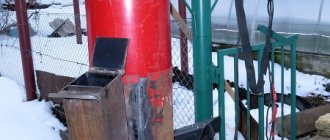Household brick stoves for coal remain worthy competitors to solid fuel boilers in a situation when it is necessary to heat a small and medium-sized dwelling in winter, and the main gas is not supplied. If according to some indicators coal stoves are inferior to steel and cast-iron heat generators, then according to other parameters they have no equal. Therefore, the demand for the construction of brick kilns remains consistently high.
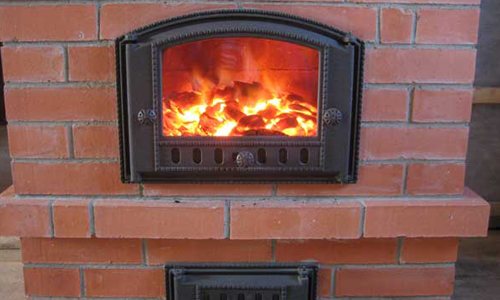
Using coal instead of wood is an inexpensive and efficient option for heating your home.
Features of the design of coal furnaces
If you look closely at a coal stove and its most common competitor, a wood-fired one, then, in principle, it will be difficult to find special differences at first glance. But with a closer examination and familiarization with the principle of operation of the furnace itself, it becomes clear that they differ fundamentally. (See also: Do-it-yourself stove housekeeper)
- The principle of combustion and air supply differs, if for wood-burning stoves the most efficient combustion can be achieved when air is supplied directly to the place of fuel combustion from above, then for coal stoves it is necessary to purge the fuel and supply the air mixture from below.
For wood-burning stoves, the use of dry fuel in the heating process is not particularly critical. It is only important that the initial kindling of the furnace occurs with dry material. It is advisable to preheat coal before adding it to the crucible in a special section of the furnace, which is heated by exhaust gases.
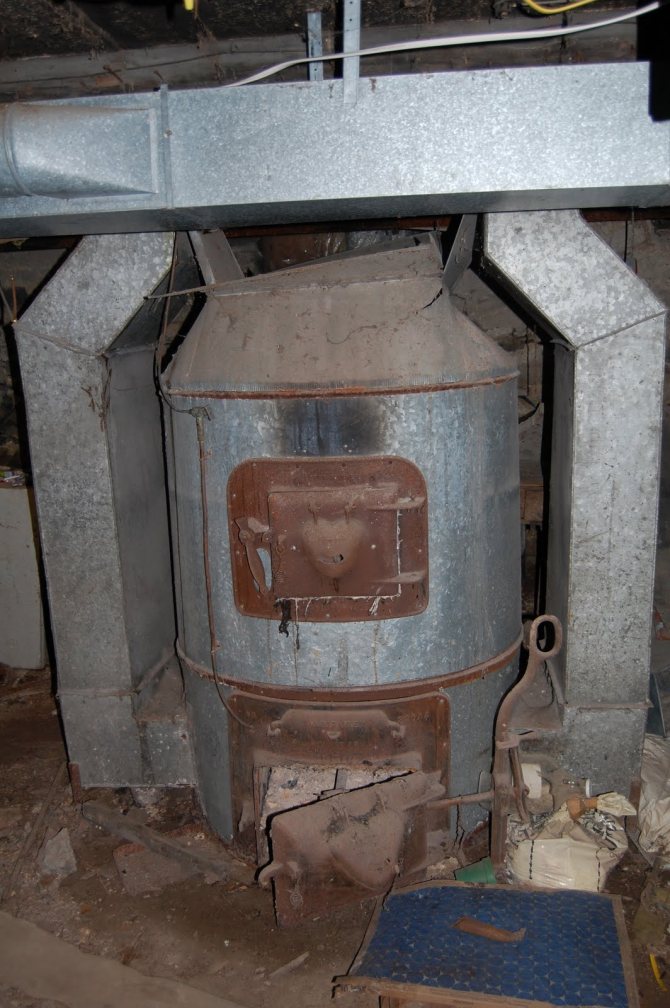

The design of the chimney for a coal stove differs slightly from wood-burning counterparts and is designed for a higher air flow rate. And the flow itself and its speed are regulated not with a yushka, but with the help of a blower. The very same damper that blocks the chimney (yushka) is completely absent. This feature is due to the fact that coal stoves smolder for a very long time, and do not quickly burn fuel like wood-burning ones. The disadvantages of coal stoves are also associated with this feature:
- it is impossible to block the chimney by preventing, the weathering of heat will be poisoned by carbon monoxide because of the danger, and therefore coal heating stoves cool down rather quickly.
- For normal combustion of a coal furnace in its lower compartment, it is desirable to exclude the presence of combustion products. To do this, it is necessary to periodically clean the ashtray, which will be constantly replenished with burnt coal. In this case, cleaning should occur more often than is necessary for a wood-burning stove.
The walls of coal stoves must withstand a higher temperature than ordinary wood stoves, respectively, they will be thicker, and more heat-resistant materials must be used for their assembly.
(See also: DIY camping stove)
A coal stove may have a special design for loading fuel, this is due to a higher ignition temperature of coal - that is, it will not be possible to flood such a stove with just a piece of newspaper and matches. Therefore, in a coal stove, firewood is first kindled, and coal is loaded from above, which gradually flares up as the wood burns out.
In practice, combined furnaces are often used, in which both coal and wood can be burned at the same time. In addition, the fuel can also be used as a fuel peat briquette, which is very similar in combustion to coal. In combined devices, all elements of both coal and wood stoves are simultaneously present.
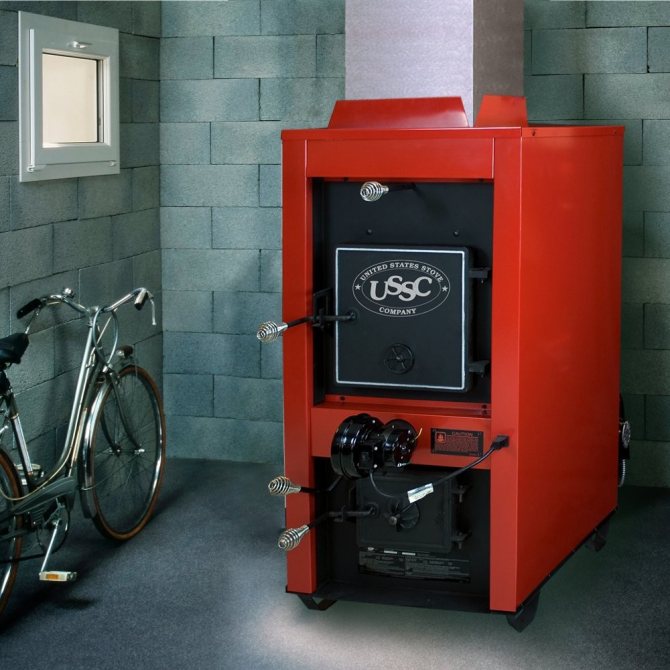

Varieties and characteristics of coal
If you are going to buy or have already bought a stove, a fireplace, for which you can use coal, we recommend not to rush with this and at the first stage to get acquainted in more detail with the main varieties of this material. As a result, you will be able to determine which coal is allowed to be used for kindling the heating unit.
The firebox of a coal stove has a lot of important nuances, which simply cannot be ignored and taken into account. Since due to improper operation of a solid fuel hearth, overheating of the structure, damage, breakage, deformation and rapid wear of materials may occur. All this can lead to fires and ignitions in the house!
Charcoal firing is, first of all, the choice of a suitable type of this fuel. It is important that the selected product has suitable characteristics, combustion temperature, optimum size and moisture content. All these parameters are more consistent with coal, which is allowed to be used in modern furnaces or steel, cast iron and refractory bricks.
Since the combustion temperature of even coal is much higher than that of classic firewood and briquettes, it is strictly forbidden to use it in those appliances in which the manufacturer does not indicate such a possibility. You can find out more about whether it is allowed to use coal for kindling the hearth from the instructions supplied with the firebox.
General concept of coal:
- Fuel belongs to the category of sedimentary rocks;
- The first formations were recorded in the Devonian period;
- Consists of carbon and non-combustible impurities. The content of the second component varies in different proportions and directly depends on which variety you are going to use for kindling;
- There is a fairly significant percentage of sulfur, which, when burned, is converted into oxide, which in turn is transformed into sulfuric acid.
Coal can differ and be classified according to its age, on the basis of which it can be represented by lignite, its surface is at the same time quite crumbly and loose, it is preferred to use it for kindling boiler equipment at TPPs. In addition to this variety, such types of coal as anthracite and the aforementioned coal are very popular.
The heating of boilers with coal is carried out only after the willows have made sure that it has a suitable percentage of moisture and contains an optimal and safe content of various bulk impurities.
If we talk in more detail about the main types of this fuel, then it is divided into the following groups. Based on which, you can buy:
- Lignite;
- Brown coal (the percentage of moisture will be about 30-40%, while the amount of components and free-flowing volatile impurities reaches 45-50 percent);
- Coal (the most optimal and most frequently used option, it has a moisture percentage not exceeding 20 percent. At the same time, the amount of volatile impurities contained in it does not exceed 35-40 percent);
- Anthracite (the indicators of this fuel are the lowest; humidity, as well as the content of volatile impurities, will be from 5 to 7%).
If you want to buy coal for a fireplace or stove, it is best to trust trusted companies that have positive reviews and sell really high-quality and proven fuel!
When buying a certain type of coal, it is important to take into account the specific heat of combustion, which will be as follows (coal):
- Brown (3-5 thousand kcal / 1 kg);
- Stone (5-5.5 thousand kcal / 1 kg);
- Anthracite (7.5-9 thousand kcal / 1 kg).
Coal
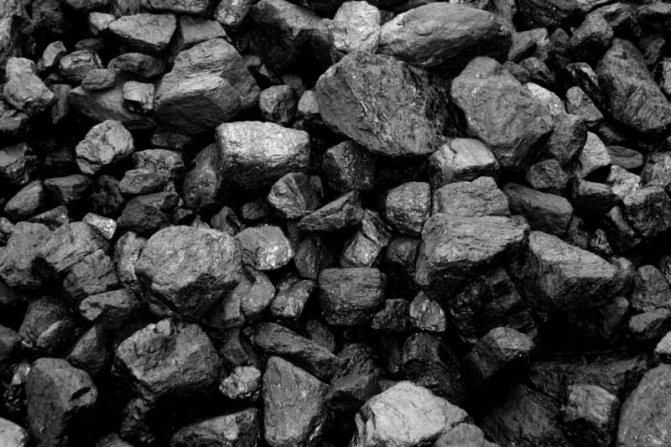

Coal is a traditional raw material for solid fuel boilers. It burns for a long time and has good heat dissipation, but only if it is correctly laid in the firebox, competent ignition and subsequent support.
Coal selection
To increase the boiler efficiency and extend its service life, it is necessary to take into account the manufacturer's recommendations for choosing a coal grade. Usually the name of the brand and its fraction is indicated in the technical passport of the device. Each of the brands has a different ratio of carbon and impurities, different moisture content, structure, strength and age of formation.
The most popular types of coal for solid fuel boilers:
- Coal. The heat transfer of the fuel is 5500 kcal / kg. The average percentage of carbon and ash is 75% / 3%. Suitable for lighting most classic boiler models.
- Anthracite. Specific heat indicators - 9000 kcal / hour. The percentage of carbon is no more than 7%. The disadvantage of the variety is the difficulty in firing up and the extremely high combustion temperature.
The most demanded and convenient for ignition is hard coal of the long-flame category. This universal fuel for all types of boilers ignites quickly, burns for a long time and gives off a large amount of energy.
You can find brown coal and lingitis on sale. However, these grades are only recommended for commercial use due to their high ash content and high humidity levels.
How to heat a boiler with coal
The solid fuel plant consists of two main chambers: the upper one is used for stowing fuel, and the lower one (ash pan) is used for collecting ash and slag. As the fuel burns in the main chamber, the combustion products gradually fall into the ash pan, from where they are removed manually.
Before starting melting, it is necessary to prepare the installation for operation. For this, solid combustion products are removed from the ash pan, the walls of the combustion chamber are wiped and the chimney channels are cleaned.
As soon as the preparatory work is completed, you can start loading fuel and igniting.
- Place dry paper on the grate of the main chamber. It is recommended to pre-crumple it - this way it will ignite faster.
- On top, evenly lay the chips, brushwood - in the form of a well or a hut.
- Light a match and bring it to the paper from different sides - the paper will evenly flare up, involving chips in the process.
- Close the firebox door, open the ash pan flap for oxygen supply. At this stage, you will have to monitor the combustion process of the chips. The intensity can be adjusted using the ash pan (blower) door.
- As soon as the chips have completely ignited, pour a small layer of fine coal on top of it. Its amount should not exceed a third of the combustion chamber.
- After loading the first batch of coal, close the door again to reach the maximum combustion temperature. This usually takes about
- When the first layer of fuel completely engulfs the flame, add the remaining coal to the upper border of the door. Beforehand, it is recommended to slightly stir the burning coal.
- Close the blower door halfway. If there is strong smoke, leave a small crack.
As the combustion progresses, fuel is added in small portions to the main chamber, each time closing the ash pan flap. Do not put a large amount of coal at once - this will lead to solidification of the fuel on the grate and its premature deterioration.
Anthracite
The owners of private heating constantly face questions - what is the best way to heat a stove or boiler, where to buy coal or firewood, how to properly heat coal?
The better to heat a stove or boiler
First of all, let's figure out why coal is better than firewood and why it is advisable to use coal for heating, and not firewood.
Comparing the prices of coal and firewood, it may seem that firewood is cheaper and therefore it is more profitable to heat with firewood. But this opinion is erroneous, and it is easy to refute it by making simple calculations. Let's divide the price of firewood by the density coefficient, which will determine how much 1 cubic meter of firewood weighs. For example, to find out the price of 1 ton of firewood, the price of 1 cubic meter of oak firewood should be divided by 0.45, spruce or alder - by 0.3.Comparing in this way the price of 1 ton of coal and firewood (even without taking into account the amount of heat emitted by them), we see that the price of firewood grows almost threefold.
Another important parameter is the heat of combustion of coal and firewood, i.e. the amount of energy (heat) released during the combustion of these fuels. Firewood is divided into three groups according to heat transfer: from 1500 kcal to 2500 kcal. Oak, birch and alder firewood has the greatest heat transfer. Slightly less heat transfer - pine and black alder, and the least - firewood for spruce, linden, white alder. Also, when evaluating the heat transfer of firewood, it is necessary to take into account their moisture content and therefore it is recommended to dry firewood in a well-ventilated room for about 3 years. Meanwhile, depending on the brand, bituminous coal, when burned, emits from 5000 kcal / kg to 8000 kcal / kg, which is two, three times more than firewood.
How to light coal
It is not easy to light coal, especially anthracite: it takes a long time to burn, but it gives a clean and stable fire and great heat transfer. To light coal, you can first light the fire with chips, old newspapers, small logs, and then pour coal on top of them. You can purchase a coal ignition: a special incendiary liquid, or a dry mixture, which is usually sold in the same place where coal is, and use it according to the instructions. You can also use a special lighter with a long "beak", which has a special locking device, which is always important in families with small children.
How to heat a stove with coal correctly
The coal stove differs from the wood stove in that the amount of coal for one firebox is loaded into the firebox in several steps so that the coal layer does not exceed 15 cm.When kindling, small firewood is used, and when it flares up, a thin one (5-6 cm) is added a layer of fine coal. After its ignition, coarse coal is poured. You can heat the stove with fine coal and even coal dust. To do this, I need to wet it, wrapping it in a newspaper, load it into the furnace along with pieces of coarse coal, placing it along the edges of the firebox. You can use a simple device in the form of cutting a tin pipe. The tin is filled from below with small firewood, and from above with coarse coal, outside it is covered with fine coal moistened with water. Then the pipe is taken out through the top burner and the oven is heated.
The next portions of coal are loaded when the previous ones are almost burnt out. To burn coal, an increased air flow is required, so the blower door is fully opened. Only when there are no blue lights in the firebox, and the slag is covered with ash, can the view or view latch be closed. In order to avoid the formation of carbon monoxide at the end of the combustion with coal, it is necessary to make sure that the walls of the furnace have warmed up enough, clean the firebox from fuel residues and only then close the chimney. The remaining fuel can be used for the next firebox.
How to heat a boiler with coal
Most coal-wood boilers are designed as two chambers, one above the other. Fuel is put in the upper chamber, ash and slag accumulate in the lower one. Between them there is a grate, usually cast iron, with high strength.
When firing coal, it is important to determine the appropriate mode and constantly maintain the burning of coal. First melt a small amount of charcoal with paper and wood chips. Pour a small amount of coal into the boiler and close the loading door. Adjust the air supply. The more oxygen is supplied, the faster the coal combustion process will take place, however, the heat obtained as a result of rapid combustion will be short-lived. Conversely, if you tightly close the door to the air supply channel, the coal will smolder, or it may even go out altogether and will not give enough heat, since it will emit a lot of smoke.
After you have adjusted the air supply system and the combustion continues evenly, add a small amount of coal to the firebox through the upper loading door. With the volume of coal in the furnace up to one third of the chamber, it will provide continuous combustion and stable heat for 3 hours. Control the coal supply to the boiler based on the water temperature sensor.
As a rule, it is sufficient to maintain the temperature within 80 ° C. To burn for a longer time, fill up and evenly distribute up to half of the chamber. Do not fill in too much coal, otherwise it will not burn out, but will sinter on the grate and it will be quite difficult to clean it.
How to heat a fireplace
If the fireplace has not been used for a long time, then the stagnant cold air in the chimney will make it difficult to kindle it, preventing the upward flow of hot gases. For this reason, it is recommended to warm up the air in the pipe before kindling. To do this, you need to take a newspaper, light it and bring it to the pipe entrance (with your hand in the firebox). After a short time, there will be a thrust, this indicates that the fireplace is ready. This means that you can start the furnace.
First, you need to light the fireplace with newsprint or wood chips. Then put wood chips, newspapers on the grate, on top - a small layer of small firewood and, finally, on top of all this - a layer of coal 5 centimeters thick. Then you need to light the kindling from below. After the fire has ignited, you need to add larger pieces of coal. Then adjust the draft with the damper.
Chemical pellets designed to light a fire are placed directly into the coal bed. The gas igniter is also added directly to the coal and is not removed until the end of the furnace. An electric igniter is placed next to the fireplace and pointed directly at the coal bed. When the coal has ignited, it is turned off.
Firewood
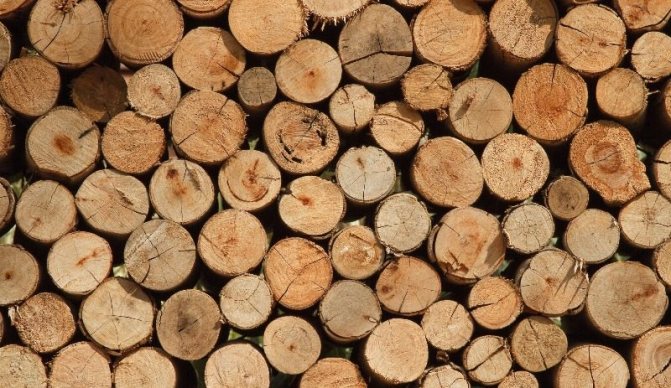

Firewood is another popular type of boiler fuel. Only dried wood is suitable for burning. Underdried firewood in the firebox begins to release moisture, which accumulates on the inner surfaces of the firebox and chimney. In combination with smoke and carbon monoxide, tar is formed - it reduces the operational properties of the boiler and reduces the permeability of the exhaust gases.
Choosing firewood
For melting, hard wood with a long burning period and slow heat transfer is optimal. Deciduous trees should be preferred over conifers. In the process of combustion, conifers emit a large amount of resinous substances, quickly contaminate the combustion chamber and heat exchanger.
According to the degree of hardness, wood species are divided into 3 categories:
- hard - white acacia, ash, beech, oak, maple, yew, hazel, pear;
- medium hardness - walnut, alder, sycamore, birch, cherry, sweet cherry, cedar;
- soft - poplar, aspen.
How to heat a boiler with wood
- At the first stage, it is necessary to warm up the heating device well. This will prevent smoke from leaking into the room. Sheets of paper are laid at the bottom of the fuel chamber, on them are flammable birch bark, chips and splinters, and on top are small logs (up to 15 cm in diameter). The space between the wood chips can be filled with paper for faster ignition.
- When the firebox is about half full, you should set fire to the paper and open the ash pan valve for better draft. Close the main chamber door.
- When the chamber and chimney are warmed up, and the preparatory bookmark begins to burn out, the firebox can be filled with large firewood. Logs can be laid out in a row or in the form of a well, leaving gaps between them for air penetration.
- As the wood burns out, you will need to make a new bookmark, without waiting for the previous one to fade.
Long-burning boilers greatly simplify the work. The fuel is loaded in them every 6 hours due to the automatic regulation of the draft and the combustion process. Such devices should be melted in accordance with the attached instructions.
How to build a stove?
First, you need to understand what the requirements are for a heating furnace for coal:
- the heater should warm up evenly and quickly, intensively giving off heat to the air in the premises;
- the outer walls of the brickwork opening into the rooms can be heated to a maximum of 90 ° C;
- fuel combustion must be efficient;
- the stove should be located in the house in such a way that its walls warm up several rooms;
- when erecting the body of the furnace and chimney, it is important to comply with all fire safety rules;
- during construction it is not allowed to use flammable materials;
- the masonry must be even, without cracking;
- the heater should be finished in accordance with the dwelling interior.
When the requirements are known and worked out in relation to your home, you should choose a suitable stove design and lay a solid foundation for it.
Laying the foundation
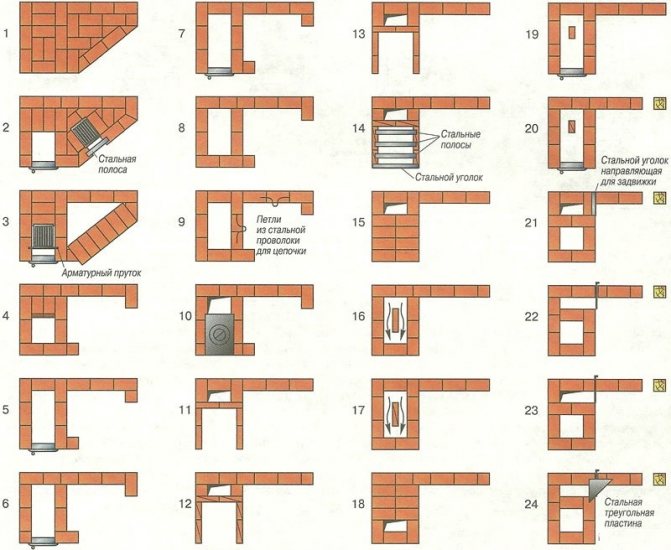

Layout of the corner oven masonry.
A coal stove is a massive and rather heavy structure, and therefore the foundation for it must be made reliable. Its dimensions in the plan are taken 5 cm more in each direction from the dimensions of the future structure.
An important condition: the foundation of a heating or cooking device made of bricks should not be joined to the base of the building itself, but be at least 10 cm away from it.
Work on laying the foundation is carried out in the following sequence:
- Dig a hole, whose depth depends on the location of non-subsiding soil layers (clay). Tamp the bottom of the pit with a manual rammer.
- Pour a layer of crushed stone with a thickness of 10-15 cm and also compact it.
- Then you can lay the foundation pit with rubble stone with watering with a liquid solution or fill in a reinforced concrete slab. The height of the base is made flush with the subfloor.
- For waterproofing on the upper part of the foundation, after the concrete has hardened, 2 sheets of roofing material must be laid, and for fire insulation - basalt cardboard and roofing steel.
After installing the foundation, you can start building the stove in accordance with the procedures.
How to calculate coal consumption
The consumption of coal in a solid fuel boiler depends on many factors. Costs are affected by:
- Heated area.
- The amount of heat loss.
- Ambient temperature.
The exact costs can be calculated only after the end of the heating season. Moreover, depending on the winter, the average consumption of coal for heating can vary from 8 to 15 tons (for a building of 200 m²).
If you make averaged calculations based on real operating experience, you can get the following data:
- Costs for September - October will amount to 1 bucket per day.
- Fuel consumption rates in a coal boiler from November to February will increase to 10 buckets per day.
- In March and April, you will need to burn 1-2 buckets per day.
Calculation of the coal consumption for a boiler of 20 kW, using the above data, will show that the costs during the heating season will amount to 580 buckets or 10-10.5 tons.
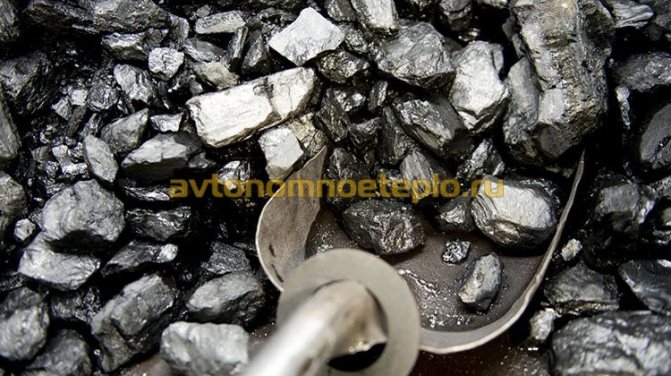

How to do it yourself
- The design of a brick oven fired with coal or briquettes is quite simple, you just need to comply with two conditions:
the firebox must be made of refractory bricks; the stove must be equipped with cleanings in all parts of the chimney.
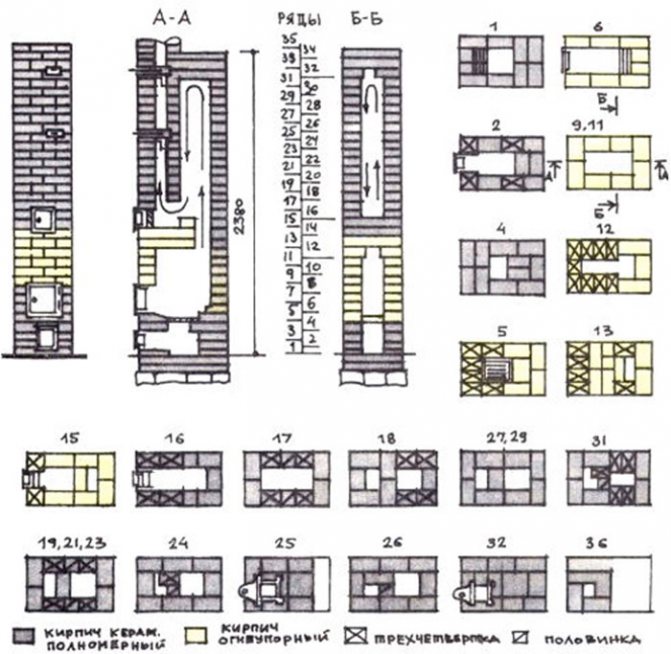

The ordering diagram of the universal furnace is shown in the figure. Thanks to a simple device, you can do it yourself, even without experience. The stove has a small size, it can be used to heat a country or country house with an area of up to 36 square meters, consisting of one or two rooms. In the latter case, the firebox is placed on the side of the kitchen, and the back wall, which heats up during the firebox, is taken out into the room.
The furnace consists of a do-it-yourself fireclay made of refractory fireclay bricks, and a supra-furnace channel with one roll-up.
The flue gases are retained in the duct, a bell effect is created, and the furnace body heats up. After cooling down, the smoke descends and through the curtain goes into the chimney. It is equipped with two dampers, eliminating the sharp boundary between warm and cold air and moisture condensation.
Below the firebox there is a blower combined with an ash pan. Pressurization is carried out through the grate, air movement is ensured by a simple chimney design and good draft.
- Install the oven on a freestanding reinforced concrete foundation. The dimensions of the foundation should exceed the dimensions of the furnace by 5-10 cm, its height is 50-70 cm, while it should be 15 cm below the level of the final floor covering. After pouring and drying the foundation, it is leveled with cement mortar, two layers of roofing material or other rolled waterproofing are laid on it, after which they begin laying the furnace with their own hands.
- They lay out two rows of bricks - the base of the furnace, with solid masonry with a red brick bandage. They are placed on a cement mortar.
- Further, the laying is carried out in accordance with the scheme for a solution of fireclay clay. The first row forms the bottom of the ash pan.
- In the second and third rows, the blower door is exposed, securing it with the help of annealed wire laid between the bricks.
- The fourth row forms the overlap of the ash chamber and an opening for a blower and ash removal from the furnace.
- Starting from the fifth row, the masonry is carried out with fireclay bricks. In the fifth row, a grate is laid.
- In the sixth and seventh, the firebox door is installed similarly to the blower door.
- Rows 9 to 11 form the walls of the furnace, they are laid with a bandage.
- In the 12th row, a vault is made of ¾ part of the brick, and in the 13th and 14th, they cover the vault.
- In the 15th row, a cleaning door and a roll-up are installed.
- Starting from the 16th row, the masonry is again made of red brick. Smoke channels are laid out according to the scheme.
- Valves are installed in the 25th and 32nd rows.
- Rows 33 and 34 complete the overlap of the furnace, then lay out the chimney of the desired height.
- The stove is dried in air, then it is carefully heated in multiple stages, first with wood, and after several furnaces with coal. During operation, it is allowed to use any solid fuel: coal, anthracite, firewood and wood waste, pellets and briquettes.
Any metal stove with the effect of long burning can be adapted for burning coal. having laid out a fireclay brick lining in the firebox with their own hands and equipped the blower with a fan. With such a refinement, the furnace metal will not burn out from high temperatures, and the coal will burn steadily for a long time.
Principle of operation
The principle of operation of a coal stove is not much different from a wood-burning stove. This is a very common misconception. Heating coal and wood-burning stoves differ radically. And here's what:
- For the combustion of coal, air must be supplied from below.
- Coal requires preheating before being sent to the furnace. Raw coal simply won't burn.
- The chimney should provide a faster passage of air than in a wood-burning stove. With this design, the damper is completely absent. The air supply is regulated from below, through the blower.
The burning process of coal takes much longer. Coal does not burn quickly like wood, but smolders for a long time. The combustion temperature is higher, which places special demands on the materials for the manufacture of the furnace. We will talk about this later.
Speaking about the process of burning coal, it is worth paying attention to one feature. If firewood in the process of pyrolysis easily decomposes into coke and gases, which have a high temperature and heat transfer, then coal burns differently. On the surface, it will have the highest temperature, and the temperature of the outgoing gases will be much lower.
A long-burning coal stove works somewhat differently than standard solid fuel boilers, to which, first of all, the logs themselves are burned and only after that the prirolysis gases themselves.
Coal-fired home stoves work according to the following principle - it is the top layer that is most susceptible to heating, a lower temperature is observed at the outlet channel. The effectiveness of such a heating unit primarily lies in the fact that the combustion chamber is large enough to hold a large amount of coal.
Wall mounted steel model, equipped with a small fuel chamber
The stove is presented in a red shade and is equipped with a sensor for monitoring temperature and pressure
Solid fuel furnace with a closed circular combustion chamber
Do-it-yourself coal stoves also require a special place, and ideally a room in which the coal will be stored. It is important that the selected space has a suitable temperature, has a low level of humidity. It is also not recommended to store coal for more than one year, since anthracite begins to cake in the fuel over time.
The disadvantages of a coal stove for a home include the fact that during operation, the space becomes easily and quickly contaminated, objects and furniture get dirty. That is why, to install this heating unit with your own hands, it is recommended to find a separate room or fence this area, equip it with easily washable surfaces.
Modern heating stoves do not require a special foundation, as they are made mainly of special alloys. There are also stainless steel ovens. The furnaces are made of heat-resistant metal structures or cast iron. The operation of the stoves implies their correct installation from the point of view of fire safety.
To do this, you need to follow the rules for installing the firebox, chimney and heating parts relative to walls and other objects. The installation scheme should also ensure uniform air convection in the room, the ability to conveniently open and close the burning furnace firebox if necessary.
Burning wood in a home stove or cooking stove is a fairly long and quite economical process, so very large spaces for storing firewood will not be needed. Systems for long burning on wood for the house often have stoves (hobs).
The scheme of their installation should provide for the use of the stove for their intended purpose with the corresponding requirements and restrictions. The installation of the stove must provide for reliable protection against movement.
In general, the design is a characteristic that may differ depending on the manufacturer and the features of a particular model. But absolutely all long-burning furnaces are made on the basis of the following elements:
- Metal body;
- Sealed sections of primary and secondary combustion;
- Adjustable air dampers.
Of course, people are interested in how such a structure works. These heaters use the principle of controlled air flow into a special chamber. Thanks to the functions of controlling the air supply to the furnace, it turns out to create a smoldering process, and the heat exchanger heats up accordingly. The house becomes warm thanks to the following actions:
- After filling the fuel, it is ignited, and the device operates at maximum capacity with the dampers fully open. This happens until the temperature reaches 200 degrees.
- After that, the flaps will close slightly and the flow of oxygen will decrease.
- The intensity of combustion decreases smoothly, and the fuel, in fact, simply begins to smolder.
- The hot heat exchanger in the structure is separated from the metal case, and air circulates freely through it. A heat exchange process takes place, during which the air heats up and provides a comfortable environment in the house.
Although at first glance, the design and operation of the device seem to be quite complex, such a heating device is easy to use and reliable. Also, long-burning furnaces have high efficiency, and some models can work for about 24 hours in stand-alone mode.
Homemade stove potbelly stove
Recently, many designers have been offering exclusive options for stoves or fireplace stoves, which are installed in country houses. For residents of prestigious cottages, they are not only an additional source of heat, but also the most beautiful accessory for the interior decoration of the premises. Such individual stoves fill the room with both warmth and special coziness. The firewood crackling in the stove or fireplace looks very beautiful and romantic when a winter blizzard is raging outside the window.
The most popular, primitive and efficient long-burning stove for temporary heating is the well-known potbelly stove. Its simple device is based on the "symbiosis" of the Russian stove and fireplace. With one load of fuel, it is able to maintain a comfortable indoor temperature for 4 hours. The potbelly stove can be installed in any space where the chimney can be brought out.
Today, everyone who has the skills to perform locksmith work can make a potbelly stove with their own hands from all kinds of scrap materials. This oven:
- Does not depend on electricity and gas.
- Easy to maintain and operate.
- Allows you to control the combustion process.
- Takes up little space.
- Compact and economical.
- May have a hole for placing utensils to cook food or heat water.
Among the disadvantages of such a furnace, it should be noted a low efficiency, a high rate of exhaust gases and rapid cooling. Therefore, to maintain the temperature in the room, it must be heated constantly.
As fuel for the stove, you can use:
Materials and equipment for independent work
Our craftsmen make stoves-stoves, having a welding machine at hand and used ones:
- large cans;
- metal corners;
- wide pipes;
- gas cylinders;
- metal boxes;
- large fire extinguishers;
- old barrels;
- steel sheets;
- chimney pipes;
- metal grates.
For the convenience of work, you can also use the technical fittings of factory production in the form of:
The main elements of the combustion unit
Detailed drawings are not needed to make a potbelly stove. The main thing is to get the most efficient design. Consider the main nodes that make up the homemade stove structure.
Combustion chamber
It is the combustion chamber that performs the function of heat transfer. The larger the area of its outer surface, the better.
It is important that the bottom of the chamber has sufficient area for storing firewood or filling coal there. Therefore, cylindrical home-made devices are placed on their side
Rectangular ovens are designed horizontally with a minimum dimensions of 250 × 350 mm.
Oversized stoves from barrels or gas cylinders are practical also in an upright position.
Finished product type
The ash pan, additionally welded or screwed to the bottom of the structure, is convenient for selecting ash. Its arrangement with a blower promotes better heat generation, and the lower door provides the required amount of oxygen and regulation of the combustion intensity.
Doors and openings
These elements are made with their own hands from the remnants of metal after cutting out the openings. After all, scraps from balloons repeat the bend of the surface, and this is very important in work. Steel door canopies are attached to the body by welding, and then the doors themselves are hung on them.
Here it is imperative to provide a locking device, which can be made like a guillotine valve or bolt.
The optimal openings for the firebox are 250 × 250 mm, for the blower - 100 mm high and 250 mm wide. The awnings are installed on the same vertical axis. A distance of approximately 10 centimeters is maintained between the openings. To prevent coals from falling out through the door, the opening of the furnace is placed slightly above the level of the grate.
A steel pipe with a diameter of 100–150 mm is used to remove flue gases in a stove. The pipe itself is not insulated - it serves as an additional source of heat. And for better heat transfer, it is placed at the outlet with inclined or horizontal sections, thereby increasing the path of warm gases.
The outlet for connecting the chimney is placed on top or better on the side. The latter option slows down the evacuation of gases, leaving room for the cooking zone.
Note! In the chimney, to regulate the intensity of the removal of hot gases, it is advisable to use a rotary or directional valve
How to choose for a home and selection criteria?
To choose the right stove, you need to consider the following:
- The design is factory-made or made by hand. Below are detailed instructions for both options.
- It will be determined by the type of oven (see the corresponding section).
- Select the required parameters. Let us dwell on this point in more detail. In order for the oven to meet expectations, you need to consider the following:
- Choose the right power. With factory devices, everything is simple - manufacturers indicate in the passport the power and cubic capacity for which the furnace is designed. It is necessary to try to ensure that the volume that needs to be heated was somewhere in the middle of the specified range. This will provide the necessary margin in case of possible heat loss. With a homemade stove, not everything is so simple. You will have to perform the calculation yourself, according to the formula:
P = (M-Bridge) * Cn / T / 1000, where
P is the required power, kW
M is the weight of the fuel used, kg
MOST is the mass of the remainder of the burnt fuel (i.e., what remains after the active phase of combustion), kg
Cn - thermal conductivity of coal, J / kg
T is the burning time of coal. M is determined by the formula: M = a * b * c * Pl * Kz, where
a, b, c - overall dimensions of the furnace from the inside, m
Pl - density of coal, kg / m3
Кз - the filling factor of the furnace (usually taken as 0.6-0.7). Having substituted the initial data, it is easy to determine the power that the furnace will produce. To determine the net power, multiply it by the furnace efficiency.
Now let's determine the required power. For 1 m2 of area, 0.1 kW of heat is needed. These figures do not take into account the possible heat loss, which is different in each room. Therefore, it is recommended to take power with a margin of 10-15%.
- Manufacturing material.
- Loading and automation volume. Coal loading in modern boilers can be automated to the point that fuel will have to be added every few weeks. The rest of the time, the oven will operate in stand-alone mode.
In order to choose the right stove for the house, stove or fireplace, it is appropriate to determine its functional purpose and how many functions it is desirable to combine with heating. The stove heats the air in the room, but if it is also used for other purposes, it can be convenient, however, if you do not need to heat, but you need a stove, this situation is not very comfortable.
We offer you to familiarize yourself with the Pipe on the roof for the stove
The use of the cheapest stove heating option, in order to heat only to heat the room in cold weather, is the cheapest type of heating in principle. On the other hand, using the surface of the stove for cooking, if you cook a lot during the cold period, is also a significant reduction in the cost of other energy sources.
Today, on the Internet, you can also find drawings of a long-burning wood-burning stove, but this is no longer very relevant, since industry and retail trade provides a really sufficient choice of various options, and making an iron furnace furnace, a stove on your own is rather complicated and, in general, not a cheap task.
The direct choice of a stove for a home is not a very simple task, but it can be simplified by dividing it into three related directions:
- Functionality - only heating or, in addition, the functions of cooking, water heating, temporary local heating, aesthetic functions (fireplace stoves) are needed;
- The volume of the heated room - this is also due to possible limitations of functionality, in addition, with large heating areas, it may be advisable to divide them into several heating devices and, accordingly, divide their functionality;
- Place of installation, heating scheme - often the choice is determined by the geometry of the space available in the installation room.
Based on the listed aspects, you can choose a specific model, focusing on its functionality and technical parameters.
The choice of a long-burning stove for your country house should be made taking into account many characteristics, the purchase of one or another option depends on each of them.
- Manufacturer's company. Here, as always, you have to choose between domestic and imported options. The former are considered cheaper, while the latter are of higher quality. Among Russian manufacturers, it is worth paying attention to the companies Brenran, Termofor and Ermak, and among foreign ones - to Zinger, La Nordica EdilKamin, etc. It is best to look for good value for money options so as not to overpay and get really reliable equipment.
- Functionality. Before buying such equipment, you need to determine its role in heating the room, whether it will be the main heating device or only an additional one. Also, experts advise buying those options that have the function of flue gas afterburning. For country houses, options with a hob will be useful.
- The speed of heating the air in the room. In this characteristic, it all depends on how often the equipment will operate. If this is a summer cottage, and heating the room is needed only sometimes, then it is better to purchase a steel model, it works much faster.
- Heated building area. Compact versions of long-burning wood-burning stoves are used as an additional source of heat. Such appliances will help heat rooms without dividing walls. As the main heat source, you can install a conventional oven with an installed water circuit. This version of the heating system will cope with heating even large country houses.
When buying or assembling long-burning coal-burning stoves with your own hands, the following points must be taken into account:
- A home-made or commercial coal-fired structure must have adequate, suitable capacity. If your house is well insulated and belongs to the category of new buildings, then in order to calculate the capacity, you will need to divide the area of all rooms in which you plan to produce heating by 10. The end result is obtained in kW. In the event that the house is far from new, about 1-1.5 kW will need to be added to the obtained value in reserve. Thus, the temperature during heating will be as comfortable as possible;
- An important role is played by the material from which the body is made, the firebox of the unit. At your discretion, you can buy a steel or cast iron model, as well as assemble it with your own hands from bricks.
With small dimensions and optimal weight, the unit combines simplicity and functionality
Mine-type boiler equipment is one of the most efficient. This unit is capable of operating without refueling for several days, however, such equipment takes up a lot of free space.
Bottom loading units are a more budget-friendly alternative. This variation is characterized by a reduced combustion chamber, thereby the equipment takes up less space. Such models are not automated and thus do not depend on the supply and availability of electricity in the house. The disadvantages include low thrust.
The model is supplemented with a spacious firebox, the sides of the case are lined with ceramics
Additional functionality is due to the presence of special pipes in the structure itself
Modern charcoal stoves for home description, types
A charcoal stove for home has a lot of advantages. The main ones among them are ease of operation and maintenance, the possibility of using another type of solid fuel instead of coal, and a large heat capacity. And besides, such a coal-fired stove for a country house can be made of different materials.
A coal-fired stove has high efficiency rates (about 60 percent, which corresponds to boilers for heating systems that use liquid fuel). Modern models allow you to control the combustion of coal in the furnace, regulate this process for a more rational use of fuel and heat.
Modern coal-fired stoves are of several types, depending on their purpose:
- heating stoves;
- heating and cooking ovens;
- household;
- fireplace stoves.
Modern furnaces are produced from different materials: refractory bricks, cast iron, steel, talc magnesite, etc.
Types of coal for the furnace
Depending on the material
Material for coal-fired stoves is the main criterion for choosing a fuel and stove. Let us examine these qualities in more detail.
For cast iron stove
Cast iron, by its characteristics, easily tolerates high temperatures, therefore, such stoves, and brick ones, are better suited for burning them with coal. Coals designated by letters:
- "A" - anthracite;
- "D" - long flame;

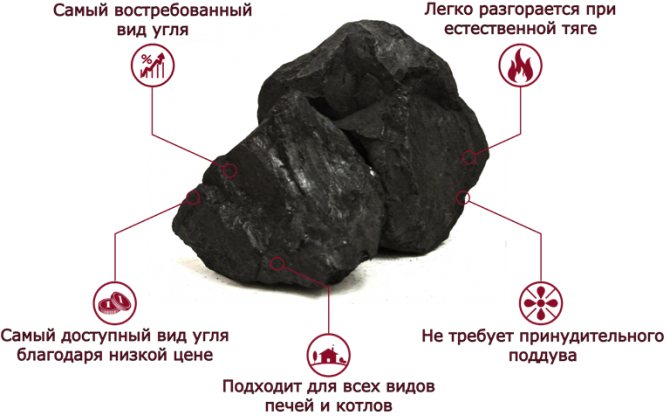
- "DG" - long-flame gas coal.
Expert opinion
Pavel Kruglov
Stove operator with 25 years of experience
This coal is better for the furnace than other types. Furnaces equipped with long-burning systems are recommended for them to use long-flame and similar gas form. Fuel "DG" is most suitable for pyrolysis types of furnaces - they have an increased formation of exhaust gases during fuel combustion, from an oxygen-depleted furnace atmosphere.
Brown coals are not suitable for cast iron stoves - a high ash content will require cleaning the chimney after 20-25 days of operation.
For brick oven
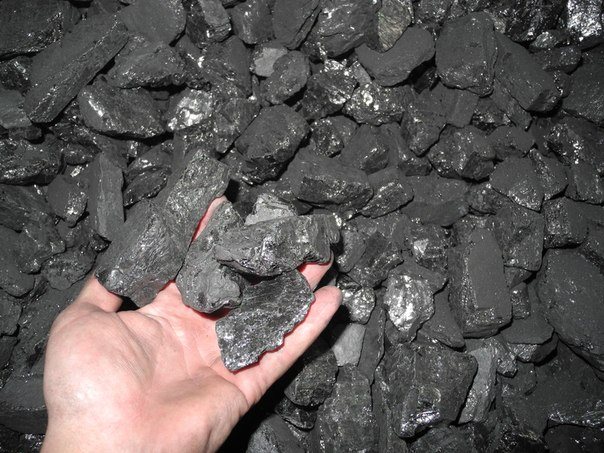

The best coal for stove and boilers is rock under the letter "A"... But some stove-makers recommend melting such stoves with long-flame coal nuts. After the temperature is set, anthracite is poured.
This option allows you to maintain the temperature in the room and save expensive anthracite. This bookmark lasts until the evening. At night, a seed is poured, which maintains the temperature in the house for 8-10 hours.
Important! Boilers and stoves of different designs can change their tastes, so go to the forum and ask what kind of fuel is suitable for your equipment.
This will not only save you money, but also allow the heater to operate normally. When choosing, a lot depends on your capabilities. You can buy fuel, grade "A" and provide yourself with anthracite with excellent characteristics.
Expert opinion
Pavel Kruglov
Stove operator with 25 years of experience
But for heating small garden houses, it is better to buy coke or even brown coal. They will cope with their task no worse than anthracite, but are much cheaper. The low price of lingitis makes such fuel in demand among summer residents or rural residents.
For steel furnace
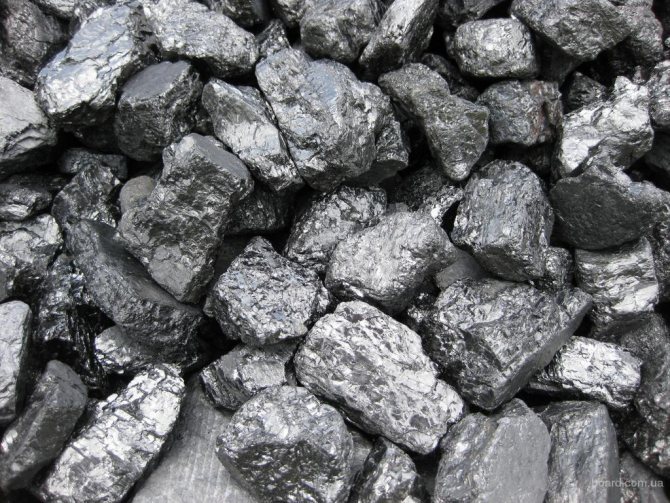

Recommend to use expensive anthracite, but coke-type fuel is also suitable... It is more important to choose the size of its fractions and apply a mixed scheme of use.
We note right away - such ovens must necessarily be made of thick and only heat-resistant steel. If you make a stove - a potbelly stove from an old barrel, it may not be finished until the end of the heating season. The high temperature during fuel combustion will require the purchase of expensive stoves with parts with a thickness of 8-10 mm. This increases the mass and its price.
If you purchased a coal-fired steel stove, be sure to read the instructions. In it, manufacturers indicate its brands and types.
Important! Regardless of the material of the stoves, before firing up the unit, be sure to open the air damper on the chimney, the firebox door and the blower and pull out the box for collecting ash. Only after making sure that there is sufficient draft, you can fill the firebox. To do this, it is recommended to use firewood for kindling, then pour the "nut" into the compartment and use the "seed" before the night.
Depending on the destination
Such fuel can be used to heat a house, greenhouse or sauna. Let's analyze the main installation sites and the choice of types for them.
For baths and saunas
If you like the smell of burnt wood, then this fuel will not work for you. Coal burns without smell and flashes of fire. Coal for the stove in the sauna, gives heavy and humid steam for the steam room... We also add a high level of ash toxicity to humans.
These are the disadvantages of such a sauna fuel. But the high temperature in a short period of time is an advantage for large baths. For a small steam room, it is better to use an old, time-tested fuel - wood.
For home heating
The choice depends on the size of the room. For a small garden house coke oven or even brown coal is suitable, but you will need to clean the chimney more often.
Such fuel has a low heating temperature than anthracite, but costs an order of magnitude lower. Long flame and long flame gas coal are preferred for heating medium to large homes. But the highest rates are given by the use of anthracite.
The choice depends on the money that you can allocate for the purchase of fuel. Using the mixed coal loading described above can significantly reduce the cost of purchasing coal. Unlike stoves in a bathhouse, the house needs to be constantly heated.
Therefore, you will need to accurately calculate the entire annual coal supply and purchase several types of fuel.
Is it possible to heat with coal
Many owners of houses with stove heating are wondering: is it possible to use coal instead of firewood in a brick stove? Will it burn as efficiently as in industrial boilers?
The process of coal combustion occurs with the release of a large amount of heat, the temperature in the furnace is significantly higher than when burning wood. At the same time, the smoke coming out of the firebox is less hot than when burning with wood.
For this reason, a conventional stove with long smoke channels cannot be fired with coal: the smoke entering the chimney will have a too low temperature, which will lead to the formation of condensation and soot. When they interact, they form carbonic acid, which destroys bricks, which can eventually cause a fire.
In addition, the high temperature in the firebox can cause its destruction. The firebox for a coal furnace made of bricks must be made only of fireclay bricks, and the walls of the furnace in this place must be thicker for high-quality removal and accumulation of heat.
It is not recommended to heat an ordinary Russian stove with coal. having a non-lined firebox and extended smoke channels! This will lead to the gradual destruction of the furnace elements!
Do-it-yourself coal stove for summer cottages
It is the cheapest way to make a brick heating stove on coal with your own hands.
Materials (edit)
We need:
- brick;
- ready-mixed mortar for laying ovens;
- cast iron grate;
- cast iron cooking stove;
- metal sheet b = 4mm - 600x1200 mm - 0.72 m2;
- welding electrodes - 1 pack.
Instruments
- trowel;
- trowels;
- hammers;
- drill;
- other.
Scheme and order
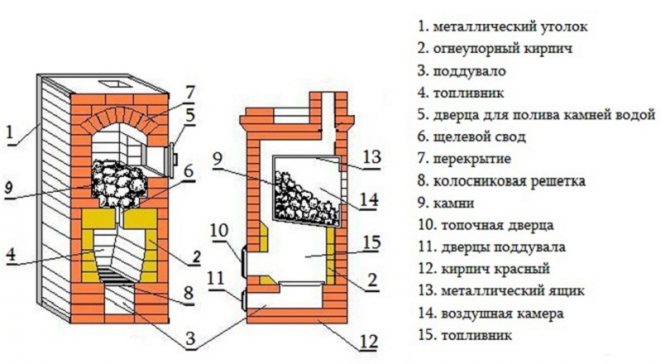

Photo №1 General view
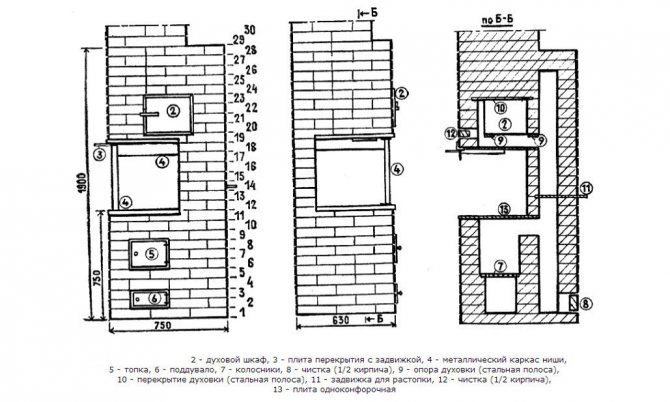

Photo # 2 Poryadovka
Description of masonry
- On top, without mortar, put a brick (see photo # 2, first row). We strictly control horizontality using a level.
- Install the blower door. We fix it with a wire and wrap it with an asbestos cord.
- We put grates directly above the blower.
- We continue laying in accordance with the order (see photo No. 2)
- Install the firebox door. We fix it with wire and bricks.
- From above, the row should overlap the fire door and end 130 mm above it.
- We continue laying, slightly shifting the bricks back. Before that, we lay an asbestos cord, on which we will install the hob.
- Let's start the formation of the chimney from the next row. The design provides for the installation of a shell pipe made of sheet metal or corrugated aluminum. The pipe should not be heavy. Otherwise, the center of gravity may shift.
- On the eleventh row, we put a valve to regulate the air flow. Do not forget to seal it with an asbestos cord and cover it with clay.
- Next, we put the chimney in the quadruple, which we join with the metal one. The pipe should be strictly vertical and not bend to the side. For greater stability, it should be covered with three rows of bricks.
- We remove the knockout bricks that we put on the 4th row, we clean the chimney from debris.
- Now the coal stove should be whitewashed. Any lime will go. Experts recommend adding blue and a little milk. So the whitewash will not darken and fly off.
- We install a metal sheet in front of the firebox.
- Install the skirting board
Do-it-yourself coal stove is not easy. It is better to seek help from an experienced stove-maker or be patient.
Other fuels for the boiler
Alternative fuels can be used to operate a solid fuel boiler.
Coal briquettes. The fuel is produced by pressing fine coal and coal dust fractions. Mineral substances or coal tar are used as a binder. The advantages of this type of fuel are ease of stacking and kindling, high heating values and excellent flammability.
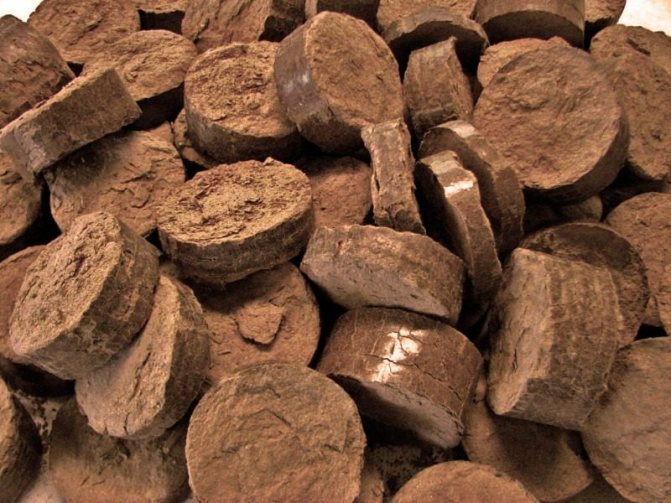

Pressed peat or wooden Euro briquettes. Fuel briquettes made on the basis of peat have a small area, while they are capable of smoldering for a long time, maintaining the phase of active combustion.
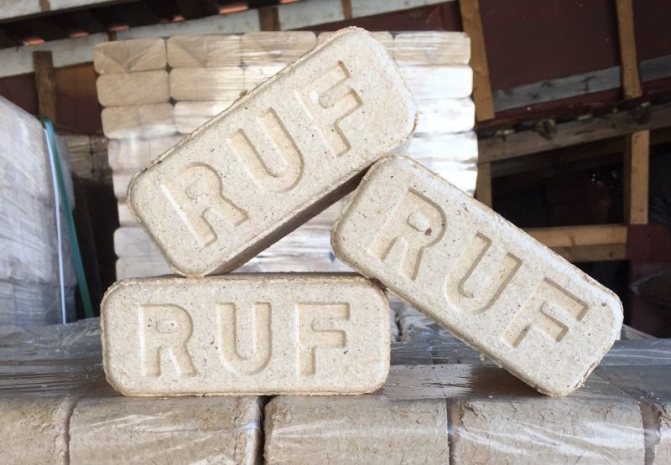

Pellets. It is a biofuel made in the form of pellets. For the production of peat, wood and agricultural waste are used. It is an environmentally friendly and energy efficient material that is preferable to use in boilers, the design of which is adapted to pellets.
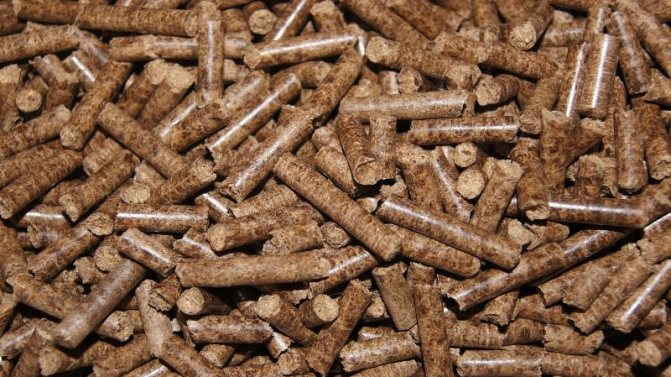

How to choose
Advantages of long-burning steel boilers:
- one-piece welded construction that is not subject to leaks;
- fast heating and cooling of the walls of the boiler and heat exchanger;
- full automation is possible due to low inertia;
- less weight;
- reasonable price.
Disadvantages of steel models:
- susceptibility to corrosion, especially in welding areas;
- steel boilers cannot be repaired; in case of perforating corrosion and leaks, the unit is replaced with a new one.
The advantages of long-burning cast iron boilers include:
- resistance of cast iron to corrosion;
- the design of the heat exchanger from separate sections allows for partial replacement in case of damage;
- cast iron is a brittle and non-plastic material, in the event of a sharp change in temperature, cracks and destruction are possible;
- higher price than steel models;
- cast iron boilers are much heavier - 1.5-2.5 times.
Loading volume and automation The frequency of filling the combustion chamber with coal depends on this characteristic. It is worth analyzing whether it will be convenient to load coal several times a day, or whether it is better to give preference to models with a large load volume. Records in terms of the duration of operation are mine-type boilers of the upper combustion. They occupy a small area, while their loading chamber is quite large, and some models can heat a house on one load for 5 days on anthracite and 3 days on brown coal. Mine boilers are usually equipped with microcontrollers to automate the entire process and keep maintenance to a minimum. Bottom loading boilers are usually smaller, much cheaper than mine boilers and easier to handle.Such boilers usually do not have a blower fan, and the air intake is due to the draft. The chimney for such a boiler should be as simple as possible and have a total length of no more than 5 meters. The advantages of boilers without traction are independence from electricity and a low price. Cons - a low level of automation. The least attention and maintenance are required by fully automated models with a loading bunker that can hold a multi-day rate of fuel. Their price, of course, is high, but they have a number of advantages that provide worry-free heating during the season:
- a fuel feed mechanism equipped with a turner;
- built-in and remote sensors that control the combustion process;
- emergency valves to prevent boiling;
- SMS alarm mode;
- function of maintaining combustion and standby mode;
- DHW circuit.
Boiler maintenance is reduced to loading the bunker at the beginning of the season and setting the parameters of the required mode.
Video: automated boiler with a hopper
The choice and purchase of a boiler is not an easy matter, and given the cost of modern models, it is also costly. Therefore, for small private or country houses, you can evaluate your strength and make a coal stove with your own hands.
Fuel combustion principle
A long-burning coal stove works somewhat differently than standard solid fuel boilers, to which, first of all, the logs themselves are burned and only after that the prirolysis gases themselves.
It is interesting to know: standard long-burning stoves for a home, the heating temperature in which is slightly lower than in coal ones, mainly consist of two main compartments. Brick, steel and cast iron fireplaces work according to the following principle: in the first chamber, the fuel turns into ash and gases, in the second, the generated gases continue to heat the unit itself and, accordingly, the room.
Coal-fired home stoves work according to the following principle - it is the top layer that is most susceptible to heating, a lower temperature is observed at the outlet channel. The effectiveness of such a heating unit primarily lies in the fact that the combustion compartment is large enough to hold a large amount of coal. Also, brick fireplaces should have thicker walls of the fuel compartment and not such a long chimney, as, for example, in standard home-made long-burning fireplaces for the house, which you can find in more detail in the video clips located on our website.
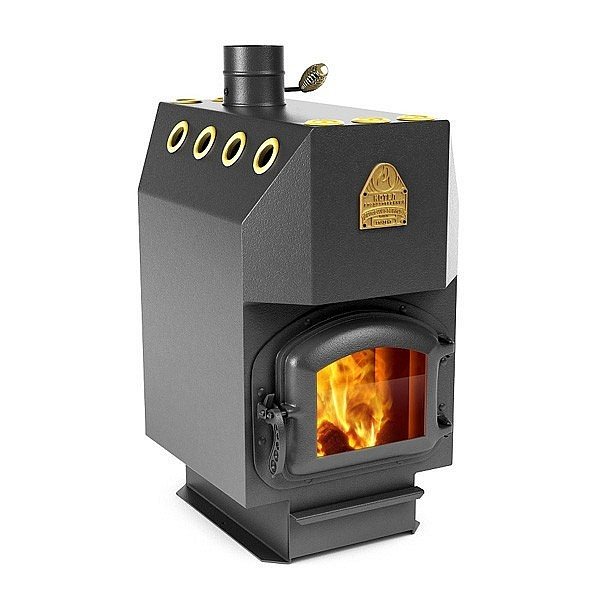

Wall mounted steel model, equipped with a small fuel chamber
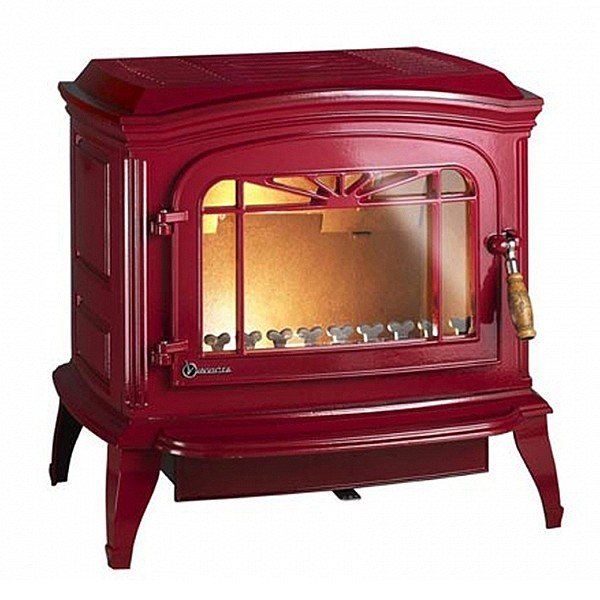

The oven is presented in a red shade and is equipped with a temperature and pressure control sensor.
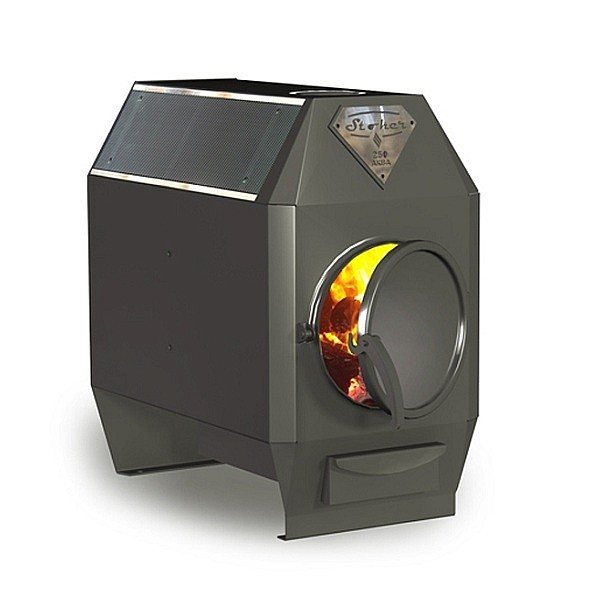

Solid fuel furnace with a closed circular combustion chamber
Important: a long-burning coal-fired stove, a video about which you can watch in this article, will have a higher efficiency if you install a blower fan in the structure itself, which will provide a high-quality forced direction of air masses into the fuel chamber. If your fireplace is made of bricks, you will need to maximize the draft level. To do this, equip the hearth with a blower, think over the design of the chimney system.
Do-it-yourself coal stoves also require a special place, and ideally a room in which the coal will be stored. It is important that the selected space has a suitable temperature, has a low level of humidity. It is also not recommended to store coal for more than one year, since anthracite begins to cake in the fuel over time.
The disadvantages of a coal stove for a home include the fact that during operation, the space becomes easily and quickly contaminated, objects and furniture get dirty. That is why, to install this heating unit with your own hands, it is recommended to find a separate room or fence this area, equip it with easily washable surfaces.
Preparatory stage for kindling the furnace
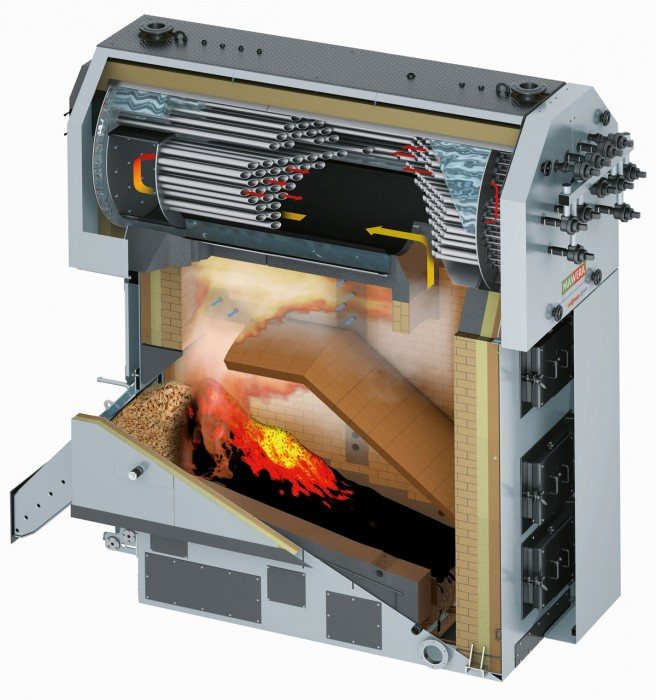

If you are going to start kindling a furnace that has not been used for a long time, a number of preparatory measures should be taken. This procedure must be carried out in order to ensure the trouble-free operation of the furnace, as well as to avoid unpleasant situations that sometimes lead to fires or harm to human health and life.
• Inspect for cracks. Their presence can contribute to the penetration of smoke and even carbon monoxide into the room. If any are found, minor repairs should be carried out immediately using a mixture of clay and sand. • Clean out soot from all gas ducts and chimney. Wipe off dust from the inner walls with a dry cloth, so as not to feel a bad aroma when kindling. In general, it is advisable to perform this procedure 2-3 times a month.
• Pay attention to the doors, especially to their fit, the functionality of the locking mechanisms, in order to avoid the appearance of smoke. • Select fuel of the proper quality, suitable for your particular type of stove
• Properly equip solid fuel storage areas.
During further operation, you should also follow a number of simple rules. The use of plastic, construction and household waste for kindling will lead to severe contamination of the stove. It is wrong to open the blower and the oven door at the same time. It should be heated several times a day for one and a half to two hours to avoid overheating. Dry, medium-sized, dust-free charcoal will provide excellent functionality.
Avoid storing flammable objects near hot walls. Do not leave the stove unattended during kindling, especially in houses where there are children.
Characteristics
When buying, you need to pay attention to the main characteristics of the fuel:
- Combustion temperature. Experts call this quality of fuel, its calorie content. The higher the number, the better the quality and performance. For example, anthracite, the most popular among the population, has a calorific value of 8750 kcal / kg. In brown ones - 6900 kcal / kg, and in coke rocks - 8400 kcal / kg.
- Ash content. This indicator can vary significantly for different brands. The lowest ash content is 25%. Low grade fuel - 40%. This quality directly affects the number of chimney cleanings.
- Internal and surface moisture level of the rock. The rocks with a high indicator of moisture content have the lowest quality level. But if the breed is kept outdoors for a long time, its surface value increases. This moisture can be easily removed by drying the fuel. This characteristic is easy to determine visually when purchasing. If individual fractions stick together in summer, and are covered with frost in winter, such fuel will have to be dried before use.

